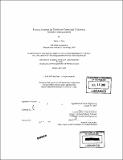Lorentz actuators for turbulence control and underwater acoustic communications
Author(s)
Sura, Daniel A
DownloadFull printable version (37.43Mb)
Other Contributors
Massachusetts Institute of Technology. Dept. of Ocean Engineering.
Advisor
Chryssostomos Chryssostomidis.
Terms of use
Metadata
Show full item recordAbstract
Lorentz actuator dynamics in a fluid are governed by the fundamental principles of electromagnetism and hydrodynamics and have several potential applications in the marine field. Two areas of interest where improvements would lead to significant contributions are the turbulence control and underwater acoustic communication fields. The ability to control turbulence is directly associated with controlling drag. Shipping industries and naval institutions are constantly seeking ways to reduce drag on marine vessels. A reduction in drag would have significant impact in the marine field allowing reduced vessel fuel consumption and faster marine travel. Experimental implementation for turbulence control was carried out at the Marine Hydrodynamics Laboratory of MIT on a flat plate setup with an integrated Lorentz actuator cassette. The data acquisition system included a dynamometer setup with integrated load cells for direct force measurements, and a Laser Doppler Velocimetry system for measuring boundary layer profiles in the flow. The results showed apparent wall shear reduction of about 30% over the Lorentz actuated cassette using the boundary layer technique but no measurable change in drag with the direct force measurement method. Most of the hardware used today in underwater acoustic communications result in a limited frequency bandwidth for data transmission and is a function of the material properties used in the design. The advantage of using Lorentz actuators for underwater sound transmission is that the frequency bandwidth is controlled by the electronics which allows us to select broader ranges of frequency transmission. A hydrophone was used to quantify acoustic noise in a conducting fluid 100 mm from the surface of a Lorentz Actuator, and was measured to be 160 dB at a frequency range from 1 kHz to 20kHz. This frequency range was limited by the driver electronics available at the time of testing, however we expect an actual range up to 100 kHz with our new equipment.
Description
Thesis (S.M.)--Massachusetts Institute of Technology, Dept. of Ocean Engineering, 2005. Includes bibliographical references (leaf 103).
Date issued
2005Department
Massachusetts Institute of Technology. Department of Ocean EngineeringPublisher
Massachusetts Institute of Technology
Keywords
Ocean Engineering.